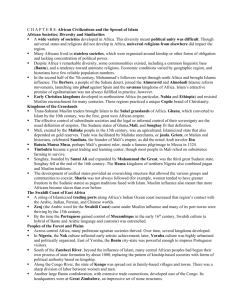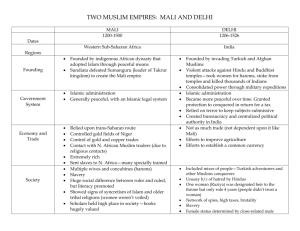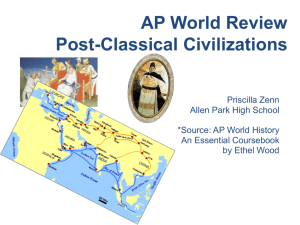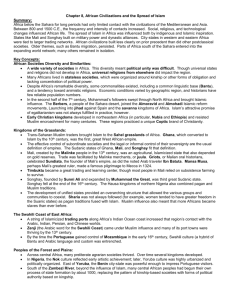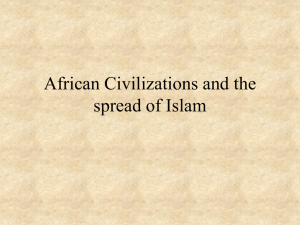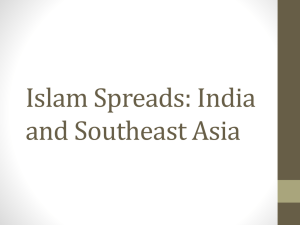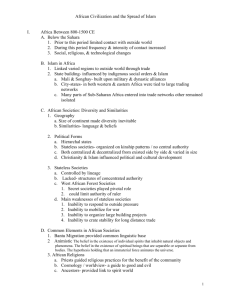Chapter 8 African civilization and the spread of Islam Do now
advertisement
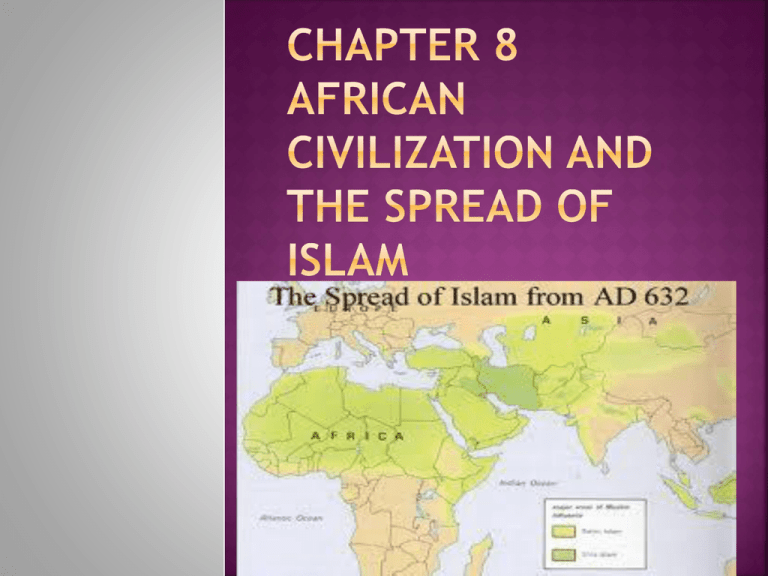
What is a stateless society? People controlled by lineage or other forms of obligation What is lacking in a stateless society? Concentration of political power and authority associated with states What most significantly impacted sub-Saharan Africa? The arrival of Islam (pg 174) 2. What was the function of secret societies in African culture Because their membership cut across lineage divisions, they acted to maintain stability within the community and diminish clan feuds (pg 175) 3. What was the indigenous religion of much of subSaharan Africa Animistic religion, belief in the power of natural forces personified as deities (pg 175) 1. Below the Sahara only limited contact with civs. of Mediterranean and Asia Between 800 and 1500 CE social, religious and technological changes influenced African life The spread of Islam in Africa linked its regions State building in Africa was influenced by both indigenous and Islamic inspiration States like Mali and Songhay built on military power and dynastic alliances City-states in western and eastern Africa were tied to larger trading networks Political forms varied from hierarchical states to “stateless” societies Both centralized and decentralized forms existed side by side and both were of varying size Christianity and Islam sometimes influenced political and cultural development In west African forest secret societies were important in social life and could limit a ruler’s authority Main weakness was their delayed ability to respond to outside pressures, mobilize for war, undertake large building projects or create stability for long-distance trade Migration of Bantu speakers provided a common linguistic base Animistic religion Religion provided a cosmology and guide to ethical behavior North Africa was integrated into the world economy Settled agriculture and ironworking were present International trade increased in some regions, mainly toward the Islamic world North Africa was integral in the classical Mediterranean civilization Mid 7th century, Muslim armies pushed westward from Egypt across the regions called Ifriqiya by the Romans and the Maghrib by the Arabs By 711 they crossed into Spain Conversion was rapid but initial unity divided north Africa into competing Muslim states In the 11th century the Almoravids of western Sahara controlled the lands expanding from the southern Savanna and into Spain 12th century another group the Almohadis succeeded the Almoravids Christian kingdoms were present in north Africa, Egypt and Ethiopia before Islam Egyptian Christians or Copts had a rich and independent tradition Coptic influence spread into Nubia (Kush) Nubians resisted Muslim incursions until the 13th century The Ethiopian successors to Christian Axum formed their state the 13th and 14th century King Lalibela in the 13th century built great rock churches Islam spread peacefully into sub-Saharan Africa Merchants followed caravan routes across the Sahara to regions where Sudanic states, such as Ghana, had flourished by the 8th century By the 13th century, new states, Mali, Songhay and Hausa were becoming important The states were often led by a patriarch or council of elders from a family Based on a ethnic core and conquered neighboring peoples Rulers were sacred individuals and separated from their subjects by rituals Two of the most important states were Mali and Songhay Mali, located along the Senegal and Niger river was formed by the Malinke people They broke away from Ghana in the 13th century Ruler authority was strengthened by Islam Agriculture, combined with the gold trade was the economic base of the state Sundiata receives credit for Malinke expansion and for governing a system based on clan structure Sundiata’s successors extended Mali’s control through most of the Niger valley to near the Atlantic ocean Mansa Kankan Musa’s pilgrimage to Mecca during the 14th century became legendary because of wealth distributed along the way Ishak al-Sahili was a architect that returned with Mansa Kankan Musa, who created a distinctive Sudanic architecture using beaten clay Western Sudan had distinctive regional towns such as Jenne and Timbuktu, whose residents included scholars, craft merchants and foreign merchants Timbuktu was famous for its library and universities Most of Mali’s population lived in villages and were agriculturalist Despite poor soil, primitive tech, droughts, insect pest and storage problems the farmers managed to support themselves and the imperial states Songhay became independent in the 7th century By 1010 the rules were Muslim and they had a capital at Gao 1370s Songhay wins freedom from Mali and prospered a trading state Sunni Ali formed a empire which extended over the entire middle Niger valley Sunni Ali developed a system of provincial admin. to secure the conquests Ali’s successors were Muslim rulers with title of askia Islamic and indigenous traditions combined Men and women mixed freely ; women went unveiled Songhay was dominate until defeated by Moroccans in 1591 The Hausa of northern Nigeria also combined cultures 14th century the first Muslim ruler Kano made the Hausa city a center of Islamic learning Larger states were ruled by a dominant group Islam provided a universal faith and a fixed law that served the common interest Rulers reinforced authority through Muslim officials and ideology Existing traditions continued to be vital as well because many of the subjects were not Muslim The fusion of traditions showed in the status of women Many Sudanic societies were matrilineal and did not seclude women The slave trade to the Islamic world had a major effect on women and children
